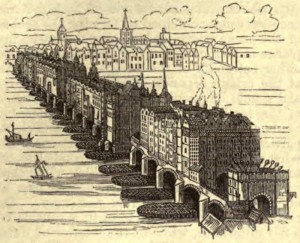Editor’s note: Hillary Brown will be participating in a webinar with the Security and Sustainability Forum tomorrow afternoon. Registration is free. Brown will be talking with Jaime Lerner and James S. Russell about the role of architecture. September 29 update: The full webinar is now available for viewing.
Today’s award-winning bridge designs, praised for their structural innovations, graceful profiles, sweeping approaches and tautly-arched spans are handsome feats of engineering. They share one limiting feature, however: effectively, they are single-purpose constructions. Besides accommodating high-volume vehicular traffic, few of these connectors perform other real consequential work. They are, in this respect, sub-optimal. Designing for shared use—accommodating multiple vs. single transit modes—offers the opportunities for shared financing and operating savings. Consider the replacement Tappan Zee Bridge, now in construction, a project that just last week was denied badly needed financing by the U.S. Environmental Protection Agency. Had the State acted on commuter preferences, incorporating light rail across this busy Hudson River crossing, instead of postponing that option, it might have a smaller funding gap to fill.
 View of Bangabandhu Bridge across the Jamuna River, Bangladesh. Photo by Ragib via Wikimedia Commons, used under Creative Commons licensing.
Successes elsewhere point to the benefits of multimodal crossings. Bangladesh’s Bangabandhu Bridge, for example, a conduit between the eastern and western halves of that nation, is a multipurpose structure that forges a vital link between Southeast Asia and northwestern Europe. It incorporates two-lane carriageways, a dual gauge railway, a high-pressure natural gas pipeline as well as high-voltage and telecommunication cables. These several functions were combined when feasibility studies for each revealed that none were viable independently.
View of Bangabandhu Bridge across the Jamuna River, Bangladesh. Photo by Ragib via Wikimedia Commons, used under Creative Commons licensing.
Successes elsewhere point to the benefits of multimodal crossings. Bangladesh’s Bangabandhu Bridge, for example, a conduit between the eastern and western halves of that nation, is a multipurpose structure that forges a vital link between Southeast Asia and northwestern Europe. It incorporates two-lane carriageways, a dual gauge railway, a high-pressure natural gas pipeline as well as high-voltage and telecommunication cables. These several functions were combined when feasibility studies for each revealed that none were viable independently.
 A woodcutting of London Bridge as it would have appeared in 1616. Woodcut published in 1879.
In medieval times, the heavily occupied, multipurpose spans of pre-industrial eras (Old London Bridge and Paris’ Pont Notre-Dame) supported dense, mixed-use real estate, responding to the confines of medieval walled cities. Multi-story houses, shops and civic space topped out these superstructures, bank to bank. Soon, more accretions, utilities such as water-powered mills and water-pumping towers, affixed themselves to these spans.
“Future-proofing” infrastructure by adopting more holistic design endeavors runs counter to the traditional siloing of infrastructural sectors. However, common sense dictates that multiuse crossings can not only accommodate more traffic modes, but also they can integrate both useful public amenities (bike and pedestrian ways) and even critical utilities. In an urbanizing world, the diversified use of bridges increases real estate productivity. Importantly, such projects can accrue capital cost savings through shared components and/or economies of scale. Co-benefits also include operational and energy efficiencies and reduced construction-related impacts of noise, traffic disruption and pollution. Sadly, New York State has forfeited these opportunities.
A woodcutting of London Bridge as it would have appeared in 1616. Woodcut published in 1879.
In medieval times, the heavily occupied, multipurpose spans of pre-industrial eras (Old London Bridge and Paris’ Pont Notre-Dame) supported dense, mixed-use real estate, responding to the confines of medieval walled cities. Multi-story houses, shops and civic space topped out these superstructures, bank to bank. Soon, more accretions, utilities such as water-powered mills and water-pumping towers, affixed themselves to these spans.
“Future-proofing” infrastructure by adopting more holistic design endeavors runs counter to the traditional siloing of infrastructural sectors. However, common sense dictates that multiuse crossings can not only accommodate more traffic modes, but also they can integrate both useful public amenities (bike and pedestrian ways) and even critical utilities. In an urbanizing world, the diversified use of bridges increases real estate productivity. Importantly, such projects can accrue capital cost savings through shared components and/or economies of scale. Co-benefits also include operational and energy efficiencies and reduced construction-related impacts of noise, traffic disruption and pollution. Sadly, New York State has forfeited these opportunities.
 View of Bangabandhu Bridge across the Jamuna River, Bangladesh. Photo by Ragib via Wikimedia Commons, used under Creative Commons licensing.
View of Bangabandhu Bridge across the Jamuna River, Bangladesh. Photo by Ragib via Wikimedia Commons, used under Creative Commons licensing. A woodcutting of London Bridge as it would have appeared in 1616. Woodcut published in 1879.
A woodcutting of London Bridge as it would have appeared in 1616. Woodcut published in 1879.


